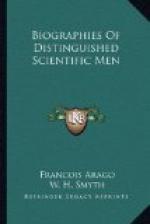Certainly no astronomer will regret that any opinions either off-hand or well digested, on the first literary productions of Bailly, contributed to throw him into the pursuit of science. Still, for the sake of principle, it seems just to protest against the praises given to the foresight of Lanoue, to the sureness of his judgment, to the excellence of his advice. What was it in fact? A lad of sixteen or seventeen years of age, composes two tolerable tragedies, and these essays are made irrevocably to decide on his future fate. We have then forgotten that Racine had already reached the age of twenty-two, when he first appeared, producing Theagenes and Charicles, and the Inimical Brothers; that Crebillon was nearly forty years of age when he composed a tragedy on The Death of the Sons of Brutus, of which not a single verse has been preserved; finally, that the two first comedies of Moliere, The three rival Doctors and The Schoolmaster, are no longer known but by their titles. Let us recall to mind that reflection of Voltaire’s: “It is very difficult to succeed before the age of thirty in a branch of literature that requires a knowledge of the world and of the human heart.”
A happy chance showed that the sciences might open an honourable and glorious path to the discouraged poet. M. de Moncaville offered to teach him mathematics, in exchange for drawing-lessons that his son received from the warder of the king’s pictures. The proposal being accepted, the progress of Sylvain Bailly in these studies was rapid and brilliant.
BAILLY BECOMES THE PUPIL OF LACAILLE.—HE IS ASSOCIATED WITH HIM IN HIS ASTRONOMICAL LABOURS.
The mathematical student soon after had one of those providential meetings which decide a young man’s future fate. Mademoiselle Lejeuneux cultivated painting. It was at the house of this female artist, known afterwards as Madame La Chenaye, that Lacaille saw Bailly. The attentive, serious, and modest demeanour of the student charmed the great astronomer. He showed it in a most unequivocal manner, by offering, though so avaricious of his time, to become the guide of the future observer, and also to put him in communication with Clairaut.
It is said that from his first intercourse with Lacaille, Bailly showed a decided vocation for astronomy. This fact appears to me incontestable. At his first appearance in this line, I find him associated in the most laborious, difficult, and tiresome investigations of that great observer.
These epithets may perhaps appear extraordinary; but they will be so only to those who have learnt the science of the stars in ancient poems, either in verse or in prose.




